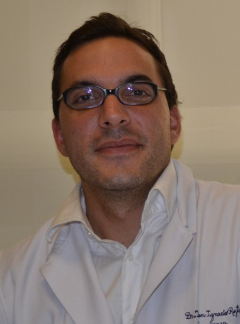
Contributions
Abstract: EP1517
Type: ePoster
Abstract Category: Therapy - disease modifying - Long-term treatment monitoring
No evidence of disease activity (NEDA) has become a treatment goal and a new outcome measure in multiple sclerosis (MS). However, the persistence of NEDA over time has no been fully analyzed. The objective was to investigate NEDA status during 5 years as measured by relapses, disability progression, and yearly magnetic resonance imaging (MRI) in a cohort of MS patients from Buenos Aires, Argentina.
Methods: Patients were selected from the longitudinal cohort of an MS center of Buenos Aires, Argentina. Patients were required to have an initial diagnosis of relapsing-remitting MS, no more than 8 years of disease onset (defined as the first demyelinating event) and a minimum of 5 years of prospective follow-up that included yearly brain MRI and biannual clinical visits. Patients were analyzed independent of disease-modifying therapy. NEDA was defined as a composite that consisted of absence of relapses, no sustained Expanded Disability Status Scale score progression, and no new or enlarging T2 or T1 gadolinium-enhancing lesions on annual MRI. Relapses, progression, and MRI changes were also investigated as individual outcomes.
Results: a total of 122 patients were included, 83 (68%) females, mean age at disease onset 33.4 ± 5.3 years, mean time follow up 6.4 ± 1.2 years, all patients received immunomodulators.. 61%(74) had NEDA for clinical and MRI measures at year 1, 38% (46) at year 2, 31% (38) at year 3, 25 % (30) at year 4 and 21 % (26) at year 5. Each year, 41% (50) to 54 % (66) of the cohort had evidence of either clinical or MRI disease activity but not both.
Conclusion: In our cohort, after 5 year of follow up, only 21% of patients had NEDA since disease onset. NEDA was difficult to sustain over the long term in our population.
Disclosure: JI Rojas has received honoraria from Novartis as a scientific advisor. He has received travel grants and attended courses and conferences on behalf of Merck-Serono Argentina, Novartis Argentina.
E Cristiano has received fees for consultations as a scientific advisory board member and for travel to meetings, conferences and clinical trials of the following companies: Avanir, Bayer, Biogen, Merck, Novartis and Teva.
L Patrucco has received honoraria for scientific and research grants from Teva Tuteur, Merck Serono, Biogen Idec and Bayer Schering.
J. Miguez, JF declares no conflict of interest
Abstract: EP1517
Type: ePoster
Abstract Category: Therapy - disease modifying - Long-term treatment monitoring
No evidence of disease activity (NEDA) has become a treatment goal and a new outcome measure in multiple sclerosis (MS). However, the persistence of NEDA over time has no been fully analyzed. The objective was to investigate NEDA status during 5 years as measured by relapses, disability progression, and yearly magnetic resonance imaging (MRI) in a cohort of MS patients from Buenos Aires, Argentina.
Methods: Patients were selected from the longitudinal cohort of an MS center of Buenos Aires, Argentina. Patients were required to have an initial diagnosis of relapsing-remitting MS, no more than 8 years of disease onset (defined as the first demyelinating event) and a minimum of 5 years of prospective follow-up that included yearly brain MRI and biannual clinical visits. Patients were analyzed independent of disease-modifying therapy. NEDA was defined as a composite that consisted of absence of relapses, no sustained Expanded Disability Status Scale score progression, and no new or enlarging T2 or T1 gadolinium-enhancing lesions on annual MRI. Relapses, progression, and MRI changes were also investigated as individual outcomes.
Results: a total of 122 patients were included, 83 (68%) females, mean age at disease onset 33.4 ± 5.3 years, mean time follow up 6.4 ± 1.2 years, all patients received immunomodulators.. 61%(74) had NEDA for clinical and MRI measures at year 1, 38% (46) at year 2, 31% (38) at year 3, 25 % (30) at year 4 and 21 % (26) at year 5. Each year, 41% (50) to 54 % (66) of the cohort had evidence of either clinical or MRI disease activity but not both.
Conclusion: In our cohort, after 5 year of follow up, only 21% of patients had NEDA since disease onset. NEDA was difficult to sustain over the long term in our population.
Disclosure: JI Rojas has received honoraria from Novartis as a scientific advisor. He has received travel grants and attended courses and conferences on behalf of Merck-Serono Argentina, Novartis Argentina.
E Cristiano has received fees for consultations as a scientific advisory board member and for travel to meetings, conferences and clinical trials of the following companies: Avanir, Bayer, Biogen, Merck, Novartis and Teva.
L Patrucco has received honoraria for scientific and research grants from Teva Tuteur, Merck Serono, Biogen Idec and Bayer Schering.
J. Miguez, JF declares no conflict of interest


